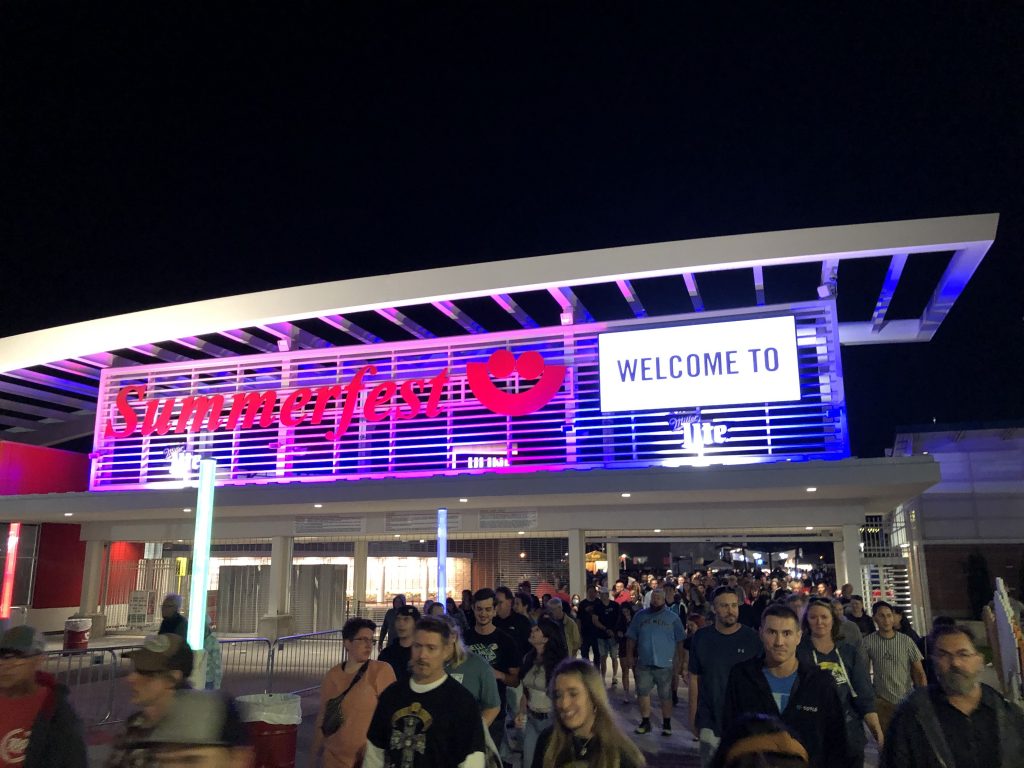Summerfest Attendance Up 40%, 3-Weekend Format To Continue
But overall attendance was still well below pre-pandemic levels.

People file out of Summerfest on the last night of the 2021 festival. File photo by Jeramey Jannene.
Summerfest, presented by American Family Insurance, wrapped up its final weekend last Saturday, bringing an end to the festival’s 55th year.
In its latest installment, which stretched over three weekends from June 22 through July 8, the Big Gig hosted a number of sold-out performances, set a new record for sponsorships and celebrated an attendance hike of 40% over the 2022 festival.
The festival reported 624,407 fans this year — a huge jump from last year’s 445,611, but still well short of 2019’s 718,144 attendee festival.
“These are fantastic results for Summerfest’s 55th anniversary,” said Don Smiley, CEO of Milwaukee World Festival, Inc. (MWF), in a statement. “As I look back on my 20 years of leading Summerfest, this year’s festival is a highlight, as our team continued to deliver a world-class experience in a world-class setting.”
MWF announced Tuesday that next year’s festival will stick to the three-weekend format. Dates for the 2024 event are June 20 through 22, June 27 through 29 and July 4 through 6. Summerfest was previously held — for more than five decades — as an 11-day festival over a period of less than two weeks.
“Summerfest’s 2023 results allow our organization to continue to position the festival for future success,” said Sarah Pancheri, president of MWF, in a statement. “The Summerfest experience remains one of the best in the business and our team looks forward to enhancing that experience in the years to come.”
Across its 12 festival stages, Summerfest hosted more than 600 artists and drew capacity crowds at American Family Insurance Amphitheater for Zac Brown Band, Zach Bryan and Imagine Dragons.
Additional highlights from the 2023 fest included performances by Earth, Wind & Fire, Santa Fe Klan, Lord Huron, Yellowcard, Lauren Daigle, Japanese Breakfast, Smokey Robinson and Styx, as well as the potentially record-breaking crowd that gathered for Noah Kahan‘s folk-infused pop set.
A nonprofit and self-described public charity, Summerfest reported distributing more than 50,000 free tickets. As part of admission promotions, festival attendees provided over 27,000 pounds of food donations for Hunger Task Force, more than $18,000 worth of hygiene products for Milwaukee and Waukesha County schools and over 3,500 books for Next Door’s community literacy initiatives.
If you think stories like this are important, become a member of Urban Milwaukee and help support real, independent journalism. Plus you get some cool added benefits.



















The downtown businesses really suffer during Summerfest. I would favor returning to the 11 day format, with 2 weekends, not 3. This economic disruption is an under-reported story.
JMcD can you please expand on this? Are you saying downtown businesses loose money during Summerfest? I can only speak anecdotally as a downtown resident who does not own a business, but it seems with the bars and restaurants that they are more packed during the Summerfest day. Maybe I am making an assumption here, but I think people are more willing to do a full day with weekends as opposed to weekdays and are also doing more than just going straight to Summerfest. Plus in terms of a disruption, wouldn’t you prefer 9 days as opposed to 11 days. That is 2 less days to deal with the disruption. Again, I don’t want to speak out of turn as there is much I don’t know or see, so I am hoping to learn more about this as you probably do have knowledge that I do not and I would like to know more. Could you please explain what you mean by the economic disruption for a better understanding?